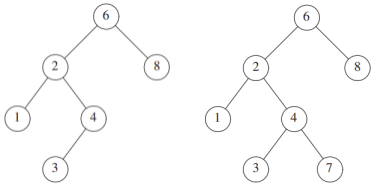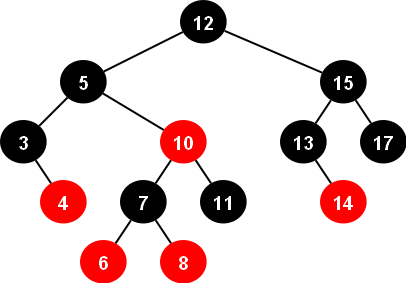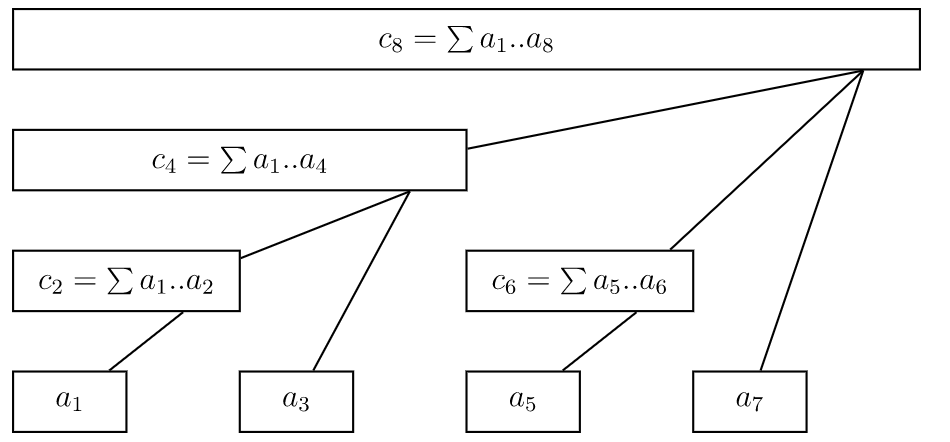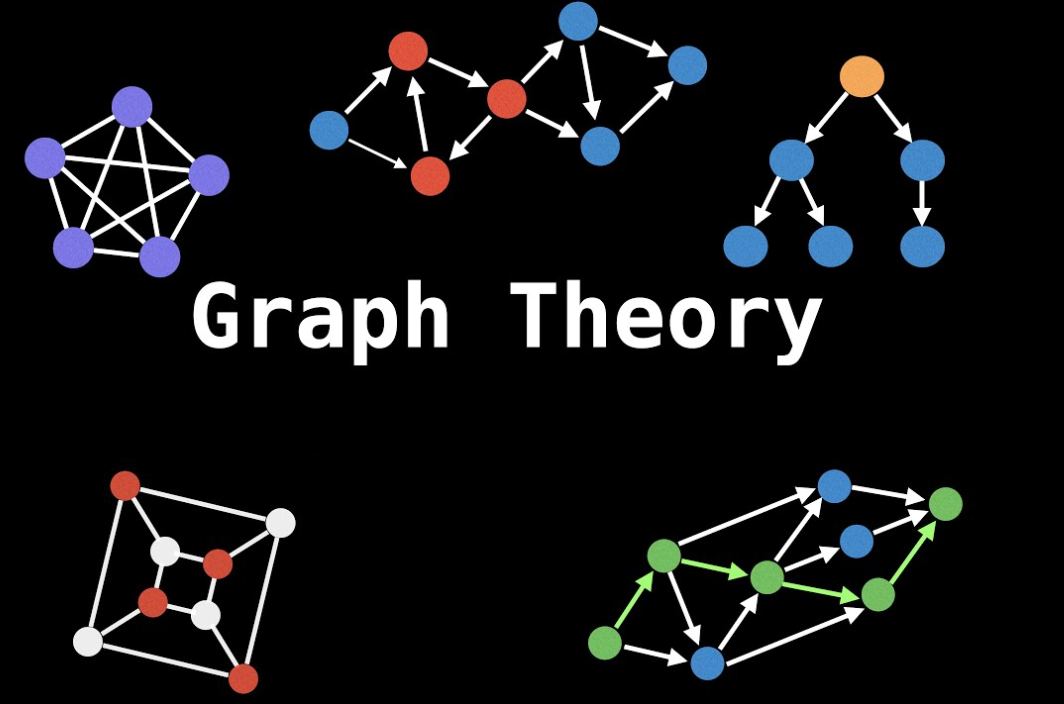二叉查找树 (树ADT连载 3/13)
可在作者的 github仓库 中获取本文和其他文章的 markdown 源文件及相关代码。
欢迎评论或仓库 PR 指出文章错漏或与我讨论相关问题,我将长期维护所有文章。
所有文章均用 Typora 完成写作,可使用 Typora 打开文章 md 文件,以获得最佳阅读体验。
🌲🌲🌲 一起手写一棵完整的二叉查找树。
❗️ 【NEW】 ❗️
这是小白 yuki 推出的「树ADT」系列文章的第 3 篇 (3/13) 。
实际上本文是为了后续讲解多种 平衡二叉树 的前置文章,最终目的是讲解 「红黑树」 (已推出,红黑树从入门到看开 )。
本文重点在于展现如何设计一个 BST 类,分析主要方法的代码实现,并给出该类的完整实现代码。读者学习之后 可以自己写出一个方法较为完备的基本 BST 类 。
yuki的其他文章如下,欢迎阅读指正!
如下所有文章同时也在我的 github 仓库 中维护。
[TOC]
二叉查找树
二叉查找树 / 二叉搜索树 / 二叉排序树 (Binary Search Tree / Binary Sort Tree, BST) : 对于一棵二叉树,每个结点存有一个可用于比较的数据项,规定结点 x x x x x x x x x x x x n n n l o g n logn l o g n 二分操作 实现 O ( l o g n ) O(logn) O ( l o g n ) 基本 BST ,由于基本BST树高不保证平衡,树上操作的复杂度无法保证为 O ( l o g n ) O(logn) O ( l o g n ) 平衡 BST 。我们将会详细几种不同的平衡 BST 实现。
根据定义可知下图中只有左侧的树是 BST ,右侧的树中结点 7 与 6 不满足 BST 的结点顺序性质,若结点 7 是结点 8 的左子结点,则为 BST。
※ 应用二叉查找树实现的数据结构一般为 s e t set se t m a p map ma p s e t set se t T r e e S e t TreeSet T ree S e t m a p map ma p T r e e M a p TreeMap T ree M a p k e y key k ey
根据 Wiki 词条,此数据结构在 1960 年代由多人独立提出。
The binary search tree algorithm was discovered independently by several researchers, including P.F. Windley, Andrew Donald Booth , Andrew Colin , Thomas N. Hibbard .
基本BST
基本 BST 即只保持 BST 结点数据项大小关系性质,而不维护树高平衡的 非平衡 BST 。所谓「平衡」,指树的形态类似等腰三角形,从根结点到任意叶子结点的路径长度都是稳定的 O ( l o g n ) O(logn) O ( l o g n ) 「任意结点的左右子树高差不超过 1」 ,如此即能保证对结点的增删改查的时间复杂度均为 O ( l o g n ) O(logn) O ( l o g n )
基本BST的定义十分简单,我们直接给出它的类的实现架构,并介绍其中的主要方法,然后再分析主要操作的时空复杂度。
本节内容为 Mark Allen Weiss 所著 数据结构与算法分析:Java语言描述 相关章节的整理和总结。代码亦来自该书,略作改动。
基本BST类架构
以下是基本 BST 类 (M y T r e e S e t MyTreeSet M y T ree S e t
类成员/方法
描述
private Node<E> root唯一字段,根结点
public MyTreeSet()无参构造器
public void clear()树置空
public boolean isEmpty()树判空
public void add(E e)插入结点驱动方法
public void remove(E e)删除结点驱动方法
public E first()查找最小结点驱动方法
public E last()查找最大结点驱动方法
public E floor(E e)查找小于等于 e e e
public E ceiling(E e)查找大于等于 e e e
public E lower(E e)查找严格小于 e e e
public E higher(E e)查找严格大于 e e e
public boolean contains(E e)结点存在判定驱动方法
public void printTree()中序遍历打印树的驱动方法
public int size()求树大小驱动方法
public int height()求树高驱动方法
private Node<E> add(E e, Node<E> t)插入结点
private Node<E> remove(E e, Node<E> t)删除结点(懒惰删除)
private Node<E> first(Node<E> t)返回树的最小结点
private Node<E> last(Node<E> t)返回树的最大结点
private Node floor(Node<E> x, E e)查找小于等于 e e e
private Node<E> ceiling(Node<E> x, E e)查找大于等于 e e e
private Node lower(Node<E> x, E e)查找严格小于 e e e
private Node<E> higher(Node<E> x, E e)查找严格大于 e e e
private boolean contains(E e, Node<E> t)判断树中是否有指定元素的结点
private void printTree(Node<E> t)中序遍历打印树
private int height(Node<E> t)求以 t t t
private int size(Node<E> t)求以 t t t
以下是二叉树结点嵌套类 N o d e Node N o d e
类成员/方法
描述
public E element结点数据
public Node<E> left左子结点
public Node<E> right右子结点
public Node(E element)构造器
public Node(E element, Node<E> left, Node<E> right)构造器
主要方法
在类架构表格中,我们看到 BST 实现的 s e t set se t M y T r e e S e t MyTreeSet M y T ree S e t
add
插入结点操作由插入驱动方和具体插入方法完成,将值为 e e e e e e e e e 作为一个叶子结点 被插入到满足查找树性质的位置。
对于具体插入方法,当原树为 n u l l null n u ll Node<>(e,null, null) 给 r o o t root roo t e e e n u l l null n u ll 插入后返回原根 。
1 2 3 4 5 6 7 8 9 10 public void add (E e) { root = add(e, root); } private Node<E> add (E e, Node<E> t) { if (t == null ) return new Node <>(e,null , null ); int cmp = e.compareTo(t.element); if (cmp < 0 ) t.left = add(e, t.left); else if (cmp > 0 ) t.right = add(e, t.right); return t; }
remove
删除结点操作由删除驱动方法和具体删除方法完成,将数据项为 e e e
首先,在驱动方法中执行 c o n t a i n s ( e ) contains(e) co n t ain s ( e ) e l e m e n t element e l e m e n t e e e t t t 懒惰删除 。删除相比其他操作要复杂一些,以下为找到时结点 t t t
情形1: t t t
情形2: t t t
情形1时,找到 t t t m i n min min t.element = min.element ,即相当于用 m i n min min t t t m i n min min
情形2时,根据是否有左子结点,执行此语句 t = (t.left != null) ? t.left : t.right 。有左子结点时 t = t.left,即用这个左子结点取代 t t t t = t.right,表示以右子结点取代 t t t t = null)。
对于具体删除方法,当原树为 n u l l null n u ll t t t r o o t root roo t r o o t root roo t n u l l null n u ll r o o t root roo t root = null )。
1 2 3 4 5 6 7 8 9 10 11 12 13 14 15 16 17 18 public void remove (E e) { if (e == null ) throw new IllegalArgumentException ("argument to remove() is null" ); if (!contains(e)) return ; root = remove(e, root); } private Node<E> remove (E e, Node<E> t) { if (t == null ) return null ; int cmp = e.compareTo(t.element); if (cmp < 0 ) t.left = remove(e, t.left); else if (cmp > 0 ) t.right = remove(e, t.right); else if (t.left != null && t.right != null ) { t.element = first(t.right).element; t.right = remove(t.element, t.right); } else t = (t.left != null ) ? t.left : t.right; return t; }
first/last
查找具有最小/最大数据的结点的操作由驱动方法和具体方法实现。根据 BST 性质一直向左/向右寻找即可找到最小/最大值。以下以递归方式实现 f i r s t first f i rs t l a s t last l a s t f i r s t first f i rs t l a s t last l a s t
1 2 3 4 5 6 7 8 public E first () { if (isEmpty()) throw new NoSuchElementException (); return first(root).element; } private Node<E> first (Node<E> t) { if (t.left == null ) return t; return first(t.left); }
floor/ceiling
f l o o r floor f l oor c e i l i n g ceiling ce i l in g
以 f l o o r floor f l oor
if (cmp == 0) return x; 若当前元素 x x x x x x if (cmp < 0) return floor(x.left, e); 若 e e e x x x x x x x . l e f t x.left x . l e f t f l o o r floor f l oor Node<E> t = floor(x.right, e); 否则此时 e e e x x x x x x
如下展示 f l o o r floor f l oor c e i l i n g ceiling ce i l in g
1 2 3 4 5 6 7 8 9 10 11 12 13 14 15 16 public E floor (E e) { if (e == null ) throw new IllegalArgumentException ("argument to floor() is null" ); if (isEmpty()) throw new NoSuchElementException ("calls floor() with empty symbol table" ); Node<E> x = floor(root, e); if (x == null ) throw new NoSuchElementException ("argument to floor() is too small" ); else return x.element; } private Node floor (Node<E> x, E e) { if (x == null ) return null ; int cmp = e.compareTo(x.element); if (cmp == 0 ) return x; if (cmp < 0 ) return floor(x.left, e); Node<E> t = floor(x.right, e); if (t != null ) return t; else return x; }
类似地,l o w e r lower l o w er h i g h e r higher hi g h er f l o o r / c e i l i n g floor/ceiling f l oor / ce i l in g
contains
寻找树中是否包含数据项为 e e e t r u e true t r u e f a l s e false f a l se
1 2 3 4 5 6 7 8 9 10 public boolean contains (E e) { return contains(e, root); } private boolean contains (E e, Node<E> t) { if (t == null ) return false ; int cmp = e.compareTo(t.element); if (cmp < 0 ) return contains(e, t.left); else if (cmp > 0 ) return contains(e, t.right); else return true ; }
时空复杂度
二叉查找树的平均深度为 O ( l o g n ) O(logn) O ( l o g n ) 平均时间复杂度 均为 O ( l o g n ) O(logn) O ( l o g n ) O ( n ) O(n) O ( n ) O ( l o g n ) O(logn) O ( l o g n ) O ( 1 ) O(1) O ( 1 )
方法
平均时间
最坏时间
add/remove/first/last/floor/ceiling/lower/higher/contains
O ( l o g n ) O(logn) O ( l o g n ) O ( n ) O(n) O ( n )
BST 平均深度为 O ( l o g n ) O(logn) O ( l o g n ) 论文 。
类的实现代码
1 2 3 4 5 6 7 8 9 10 11 12 13 14 15 16 17 18 19 20 21 22 23 24 25 26 27 28 29 30 31 32 33 34 35 36 37 38 39 40 41 42 43 44 45 46 47 48 49 50 51 52 53 54 55 56 57 58 59 60 61 62 63 64 65 66 67 68 69 70 71 72 73 74 75 76 77 78 79 80 81 82 83 84 85 86 87 88 89 90 91 92 93 94 95 96 97 98 99 100 101 102 103 104 105 106 107 108 109 110 111 112 113 114 115 116 117 118 119 120 121 122 123 124 125 126 127 128 129 130 131 132 133 134 135 136 137 138 139 140 141 142 143 144 145 146 147 148 149 150 151 152 153 154 155 156 157 158 159 160 161 162 163 164 165 166 167 168 169 170 171 172 173 class MyTreeSet <E extends Comparable <? super E>>{ private Node<E> root; public MyTreeSet () {} public void clear () { root = null ; } public boolean isEmpty () { return root == null ; } public void add (E e) { root = add(e, root); } public void remove (E e) { if (e == null ) throw new IllegalArgumentException ("argument to remove() is null" ); if (!contains(e)) return ; root = remove(e, root); } public E first () { if (isEmpty()) throw new NoSuchElementException (); return first(root).element; } public E last () { if (isEmpty()) throw new NoSuchElementException (); return last(root).element; } public E floor (E e) { if (e == null ) throw new IllegalArgumentException ("argument to floor() is null" ); if (isEmpty()) throw new NoSuchElementException ("calls floor() with empty symbol table" ); Node<E> x = floor(root, e); if (x == null ) throw new NoSuchElementException ("argument to floor() is too small" ); else return x.element; } public E ceiling (E e) { if (e == null ) throw new IllegalArgumentException ("argument to ceiling() is null" ); if (isEmpty()) throw new NoSuchElementException ("calls ceiling() with empty symbol table" ); Node<E> x = ceiling(root, e); if (x == null ) throw new NoSuchElementException ("argument to ceiling() is too large" ); else return x.element; } public E lower (E e) { if (e == null ) throw new IllegalArgumentException ("argument to lower() is null" ); if (isEmpty()) throw new NoSuchElementException ("calls lower() with empty symbol table" ); Node<E> x = lower(root, e); if (x == null ) throw new NoSuchElementException ("argument to lower() is too small" ); else return x.element; } public E higher (E e) { if (e == null ) throw new IllegalArgumentException ("argument to higher() is null" ); if (isEmpty()) throw new NoSuchElementException ("calls higher() with empty symbol table" ); Node<E> x = higher(root, e); if (x == null ) throw new NoSuchElementException ("argument to higher() is too large" ); else return x.element; } public boolean contains (E e) { return contains(e, root); } public void printTree () { if (isEmpty()) System.out.println("Empty tree" ); else printTree(root); } public int size () { return size(root); } public int height () { return height(root); } private Node<E> add (E e, Node<E> t) { if (t == null ) return new Node <>(e,null , null ); int cmp = e.compareTo(t.element); if (cmp < 0 ) t.left = add(e, t.left); else if (cmp > 0 ) t.right = add(e, t.right); return t; } private Node<E> remove (E e, Node<E> t) { if (t == null ) return null ; int cmp = e.compareTo(t.element); if (cmp < 0 ) t.left = remove(e, t.left); else if (cmp > 0 ) t.right = remove(e, t.right); else if (t.left != null && t.right != null ) { t.element = first(t.right).element; t.right = remove(t.element, t.right); } else t = (t.left != null ) ? t.left : t.right; return t; } private Node<E> first (Node<E> t) { if (t.left == null ) return t; return first(t.left); } private Node<E> last (Node<E> t) { while (t.right != null ) t = t.right; return t; } private Node floor (Node<E> x, E e) { if (x == null ) return null ; int cmp = e.compareTo(x.element); if (cmp == 0 ) return x; if (cmp < 0 ) return floor(x.left, e); Node<E> t = floor(x.right, e); if (t != null ) return t; else return x; } private Node<E> ceiling (Node<E> x, E e) { if (x == null ) return null ; int cmp = e.compareTo(x.element); if (cmp == 0 ) return x; if (cmp > 0 ) return ceiling(x.right, e); Node<E> t = ceiling(x.left, e); if (t != null ) return t; else return x; } private Node lower (Node<E> x, E e) { if (x == null ) return null ; int cmp = e.compareTo(x.element); if (cmp <= 0 ) return lower(x.left, e); Node<E> t = lower(x.right, e); if (t != null ) return t; else return x; } private Node<E> higher (Node<E> x, E e) { if (x == null ) return null ; int cmp = e.compareTo(x.element); if (cmp >= 0 ) return higher(x.right, e); Node<E> t = higher(x.left, e); if (t != null ) return t; else return x; } private boolean contains (E e, Node<E> t) { if (t == null ) return false ; int cmp = e.compareTo(t.element); if (cmp < 0 ) return contains(e, t.left); else if (cmp > 0 ) return contains(e, t.right); else return true ; } private void printTree (Node<E> t) { if (t != null ) { printTree(t.left); System.out.println(t.element); printTree(t.right); } } private int height (Node<E> t) { if (t == null ) return -1 ; else return 1 + Math.max(height(t.left), height(t.right)); } private int size (Node<E> t) { if (t != null ) { if (t.left != null && t.right != null ) { return 1 + size(t.left) + size(t.right); } else { return t.left != null ? 1 + size(t.left) : 1 + size(t.right); } } return 0 ; } private static class Node <E>{ public E element; public Node<E> left, right; public Node (E element, Node<E> left, Node<E> right) { this .element = element; this .left = left; this .right = right; } } }
测试代码
1 2 3 4 5 6 7 8 9 10 11 12 13 14 15 16 17 18 19 20 21 22 23 24 25 26 27 28 29 30 31 32 33 34 35 package com.yukiyama;import java.util.NoSuchElementException;public class MyTreeSetDemo { public static void main (String[] args) { MyTreeSet<Integer> t = new MyTreeSet <>( ); int [] elements = {10 ,98 ,61 ,13 ,8 ,20 ,48 ,29 ,47 ,74 }; for (int e : elements) t.add(e); t.add(10 ); t.printTree(); System.out.printf("size: %d, height: %d, min: %d, max: %d\n" , t.size(), t.height(), t.first(), t.last()); System.out.printf("has 47? %s, has 100? %s\n" , t.contains(47 ), t.contains(100 )); System.out.printf("floor(9): %s, floor(10): %s, ceiling(73): %s, ceiling(98): %s\n" , t.floor(9 ), t.floor(10 ), t.ceiling(73 ), t.ceiling(98 )); System.out.printf("lower(9): %s, lower(10): %s, higher(73): %s, higher(61): %s\n" , t.lower(9 ), t.lower(10 ), t.higher(73 ), t.higher(61 )); t.remove(47 ); t.remove(48 ); t.remove(61 ); t.printTree(); System.out.println("is empty: " + t.isEmpty()); t.clear(); System.out.println("is empty: " + t.isEmpty()); System.out.printf("size: %d, height: %d\n" , t.size(), t.height()); } }






